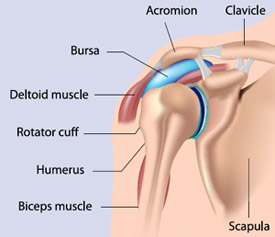Understanding your shoulder injury

 Download this info as a PDF or read below:
Download this info as a PDF or read below:
Your shoulder is made up of several joints, tendons and muscles which make it the most movable and unique joint in your body. The information provided here is based on the most current research on shoulder injuries to help you understand your injury and recovery. If you have any questions about the information you read here, please talk to your health care provider.
Shoulder basics
- Shoulder injuries are common musculoskeletal conditions.
- Most shoulder injuries are diagnosed based on your symptoms and the clinical exam performed by your health care provider.
- Most discomfort from shoulder injuries will settle down as your body heals, usually in days to weeks. You can also help healing by using simple over-the-counter medications and by performing gentle movement exercises.
- Some gentle activities that slightly increase your pain may be helpful for your recovery. Activity may be painful but not harmful. If this increased discomfort concerns you, talk to your health provider.
- Resting for long periods of time is not helpful and may make your shoulder pain worse over time. Prolonged rest and being inactive may delay your recovery putting you at risk for further injuries.
Activity will help your recovery
Maintaining a positive attitude and good physical health is important to your recovery and overall well-being. Most injuries get better with time.
- Walking is great exercise for your heart and lungs. It promotes good circulation, the healing process, and is also important for your bone and muscle health.
- Gentle movement exercises for your shoulder joint are important to improve flexibility and strength.
- Planning, pacing and changing your activities are helpful when performing tasks. It is also important to balance the activities with short breaks, as needed.
- Set goals for yourself to progress your activities each day.
Working with a shoulder injury
- Staying at work when possible is best for your recovery. Research shows that people get better and are healthier when they stay at work.
- Talk with your employer and health care provider to identify the tasks and duties that you can safely do while you are recovering. Be open to trying modified activities and duties during your recovery.
- Good posture is important to help you manage any pain you may have, especially if your symptoms came on slowly.
- Keeping your back straight and shoulders relaxed allows your muscles to work more efficiently and use less energy, therefore preventing muscle fatigue, strain and overuse injuries.
Shoulder treatment
- Research has proven that exercise programs, including a mix of supervised and home exercises, focusing on stretching and strengthening, are very effective in treating shoulder injuries and improving function.
- When going to sleep, try putting a pillow under the arm of your injured shoulder when lying on your uninjured side. This will put your shoulder in a neutral position, which means there is less tension on your shoulder joint. As a result, this position may be more comfortable.
- Most shoulder injuries improve without the need for surgery. However, there are a few conditions where shoulder surgery is required.
About your health care provider
Your health care provider will give you detailed information on your shoulder injury and your recovery.
- Your health care provider may tell you not to move your shoulder temporarily; however, remember to keep moving your fingers, wrist and elbow which will promote healthy circulation.
- Medications may be prescribed for you to help with your recovery and pain.
- If you have any concerns about your injury, talk to your health care provider.
Common terms and definitions
- Strain is an injury to a muscle and/or tendon. Tendons are cords of tissue that attach muscles to bone.
- Sprain is a stretch and/or tear of a ligament, a band of tissue that joins the end of one bone with another. Ligaments stabilize and support the body's joints.
- Impingement syndrome is when there is not enough space below the acromion for the tendons to pass freely, particularly when the arm is lifted above shoulder height.
- Tendinitis is when the shoulder tendons are irritated or inflamed.
- Rotator cuff tear is a tear of one or more tendons of the four rotator cuff muscles that work to stabilize the shoulder when you move your arm. Rotator cuff tears can vary in size.
DISCLAIMER: This information is not meant to take the place of consultation with your health care provider or the services you may need to manage your injury. Please see your health care provider about any personal health concerns.






